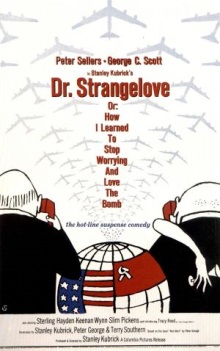
Some films have become so strongly entrenched in popular culture that you almost don’t have to watch them to know all about them. Their tropes, jokes and characters have been referenced endlessly in subsequent works and more pertinently in forum and blog posts on the Internet so much so that you might not even realize that you’re watching the source material. Stanley Kubrick’s Dr. Strangelove is an example of such a film.
So the question is for someone who has heard the “no fighting in the war room” quote multiple times, who is aware of the “riding the bomb” meme, and for whom the Cold War and the fear of nuclear Armageddon are ancient history, is this film still worth watching? And the answer is a resounding yes! Given the recent crisis in Ukraine and how it reinforces the value of the nuclear deterrent, it is even more relevant now than it has been for many years.
There is so much that is great about this film that it’s hard to list them all. Most obviously we have Peter Sellers’ performance as three characters so different from one another you probably wouldn’t have realized were all being played by the same actor if you weren’t previously informed. My favourite of the three roles is RAF officer Lionel Mandrake who at first can’t quite believe that his superior officer is stark raving mad (“a little funny in the head” as he puts it when playing President Merkin Muffley) and later gingerly handles the madman to extract the communication codes from him.
But the other actors are just as good. Sterling Hayden’s conspiracy-crazy General Ripper is distinct from George Scott’s jingoistic and opportunistic General Buck Turgidson. Slim Pickens’ “cowboy” B-52 commander is one of the actor’s most famous roles for good reasons. True, these are all stereotypes and Kubrick’s deliberately upped the caricature dial up to eleven. In the case of Scott, he even tricked the actor into playing the role more ridiculously than the actor was comfortable with by claiming that it was a rehearsal but then used the filmed scene in the final scene. But since this is comedic satire, it works perfectly.
In my post on Captain Phillips, I criticized the odd obsession with showing every detail of American’s military paraphernalia. In the scenes aboard the B-52, Dr. Strangelove similarly walks us through every aspect of how a bombing run is conducted, from authorization to target selection to opening the bomb bay doors. But while the scenes seemed gratuitous in Captain Phillips, here the very methodicalness of the procedure is a chilling reminder that the crew is effectively unleashing nuclear hell based on the orders they’ve received and they have absolutely no room for personal judgements or regrets. Here the wealth of detail is even more impressive when you realize that this was supposed to be classified information at the time.
As you would expect from a Kubrick work, this is a perfectly paced production with a great eye for all the right details at the right time. The only shortcoming I can think of is that the visual effects of the flying B-52 are probably a touch too cheesy, given how realistic the interior of the plane looks. I liked the little touches like Miss Foreign Affairs and the Coca-Cola vending machine. I wouldn’t say that this a laugh-out-loud movie but it is deliciously and wickedly fun.
Above all, this is a movie that regardless of being in black-and-white has not aged at all since the day it was released. Not only is it still relevant, it is still intelligent, funny and entertaining. A highly recommended watch.
One thought on “Dr. Strangelove (1964)”